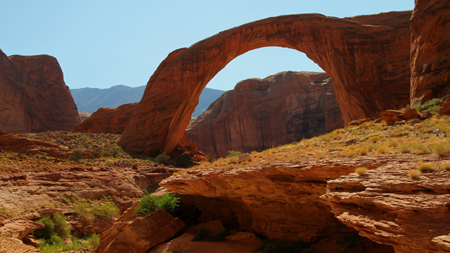Rainbow Bridge National Monument |
Rainbow Bridge National Monument "Custom Tours"
We offer escorted tours by boat to Rainbow Bridge National Monument, the largest and most beautiful natural bridge in the world. Depending on the water level and boat used, this is a 3 to 6 hour boat tour. This custom tour is uaually part of one of our "Custom Day Tours" or part of a longer multi-day Custom Tour. Our escorted Rainbow Bridge tour can be part of a larger group tour on a large size boat or it can be on a smaller size speed boat. When the lake is high, very little or no walking is require to get to the bridge by boat. In very low water years a one way hike of up to 3/4 of a mile is required. But the walk is more than worth the effort. It is a spectacular span of sandstone perfectly carved into an elegant natural bridge.
Located in an isolated canyon at the feet of Navajo Mountain, Rainbow Bridge was known for centuries by the ancient Pueblo people, who considered the bridge to be sacred. Much later, Paiute and Navajo groups named the bridge Nonnezoshe or "rainbow turned to stone." Several Native American families still reside somewhat near the area.
By the 1800s, Rainbow Bridge had been seen by wandering trappers, prospectors, and cowboys. Its existence was not publicized to the outside world until 1909. Two separate exploration parties - one headed by University of Utah dean Byron Cummings, and another by government surveyor, W.B. Douglass - began searching for the legendary span. Eventually, they combined efforts. Paiute guides Nasja Begay and Jim Mike led the way, along with trader and explorer John Wetherill. Late in the afternoon of August 15, 1909, coming down what is now Bridge Canyon, the party saw Rainbow Bridge for the first time.
The next year, on May 30, 1910, U.S. President William Howard Taft used a presidential proclamation to designate Rainbow Bridge National Monument. Teddy Roosevelt and Zane Grey were among the first visitors to make the trek by foot and horseback from Navajo Mountain. Rainbow Bridge became more accessible with the popularity of river running in Glen Canyon after World War II, although the trip still required several days floating the Colorado River plus a seven-mile hike up-canyon. By the early 1950s, people could travel upstream by jet boat from Lee's Ferry. Glen Canyon Dam was authorized in 1956. By 1963, the gates on the dam closed and rising Lake Powell began to engulf the river and its side canyons. Higher water made motorboat access to Rainbow Bridge much easier, bringing thousands of visitors to the monument each year.
Lake Powell, named after Major John Wesley Powell, a one-armed Civil War veteran who explored the river area in 1869, lies partly in Northern Arizona and mostly in Southern Utah. Its scenery is no less than spectacular, with unadulterated red sandstone cliffs and monuments reflecting with a shimmering golden glow in the deep blue water; spires, ridges, and buttes that once soared high above the Colorado River, now lone islands isolated by the crystal clear water; and beaches of rosy sand tenderly lapped by gentle rippling waves.
